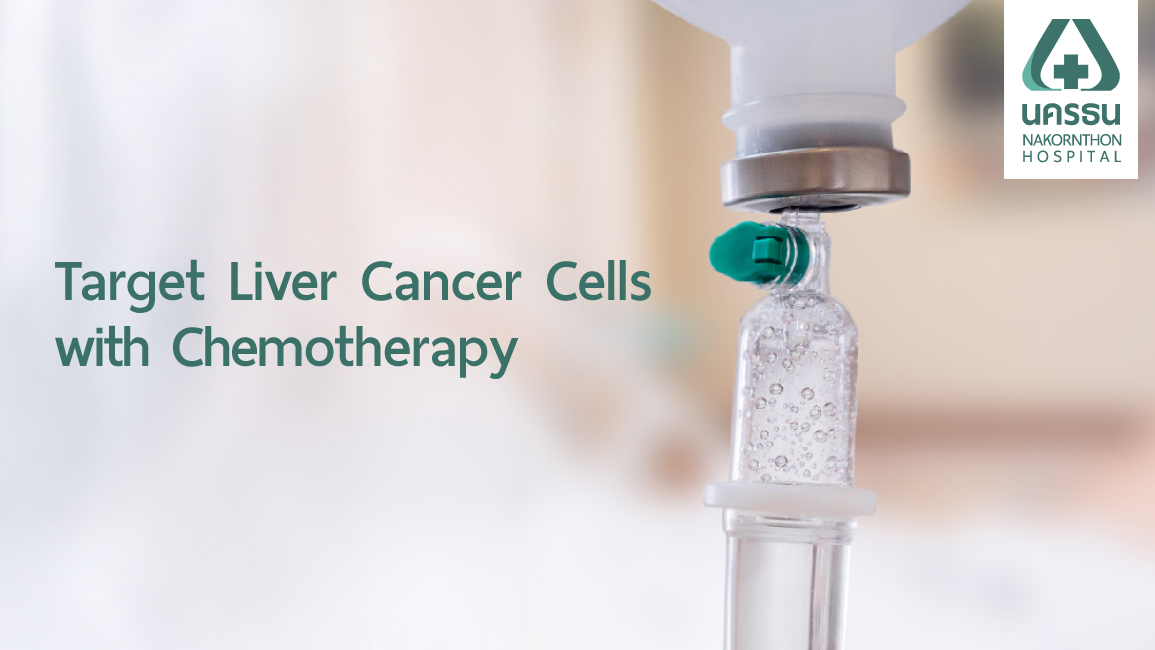TACE Liver Cancer Treatment: Direct Chemotherapy to Tumor
Center : Gastrointestinal and Liver Center
Article by : Dr. Sombun Rungjiratananon

Transarterial Chemoembolization (TACE) is one of the most effective liver cancer treatments for patients who are not eligible for surgery. This TACE procedure involves delivering targeted chemotherapy directly through the hepatic artery that feeds the liver tumor, followed by embolization to block blood flow. The goal is to shrink the tumor, reduce pain, and prevent complications
Table of Contents
- What is TACE?
- What are some common uses of TACE treatment?
- What are the benefits of TACE?
- What are the risks of TACE?
- Procedure for Treating Liver Cancer with TACE
- Preparation before TACE
- Post-TACE Care Instructions
- Liver cancer treatment with TACE at Nakornthon Hospital
- Free Online Consultation with a Specialist
What is TACE?
Normally, liver cells are nourished by blood from the portal vein. However, liver tumors rely heavily on the hepatic artery for blood supply. By delivering localized chemotherapy via this artery and then blocking it, the tumor is deprived of blood, leading to cell death.
TACE liver treatment is considered a palliative method for those ineligible for surgery or as a presurgical approach to shrink the tumor. The TACE procedure is typically repeated every 6–8 weeks to eliminate residual or newly developed cancer cells due to new blood vessels from surrounding healthy tissue.
What are some common uses of TACE treatment?
TACE is often used when:
- The tumor is larger than 4–5 cm, or when multiple tumors are present, where RFA (radiofrequency ablation) is no longer suitable.
- The tumor has not yet invaded the liver’s major veins.
- Surgical removal is too risky due to limited liver reserve or high surgical risk.
- Tumor size needs to be reduced for liver surgery or transplant eligibility.
- Palliative care is needed to manage pain or stop internal bleeding from ruptured hepatic vessels.
For smaller tumors, alternative treatments like Targeted Therapy or Chemotherapy may be evaluated.
What are the benefits of TACE?
TACE HCC (for hepatocellular carcinoma) offers several advantages:
- Effectively stops tumor growth or causes shrinkage.
- Minimizes systemic side effects since the chemo drugs are delivered directly to the liver, reducing their presence in the bloodstream.
- Faster recovery compared to surgery—general anesthesia is not required.
- Repeatable for new or recurring tumors, depending on patient health and treatment response.
In cases where bone marrow transplant is not indicated, HCC TACE remains a frontline option for non-surgical patients.
What are the risks of TACE?
Possible TACE side effects include:
- Bruising (ecchymosis) at the catheter insertion site, typically resolving within a few days.
- TACE syndrome (Post-embolization syndrome): symptoms like abdominal pain, nausea, vomiting, fatigue, and low-grade fever—common in 40% of patients and usually resolves within 1–2 weeks.
- Less common risks: ascites, liver abscess, bloodstream infection.
Awareness of TACE refractoriness is important—some patients may not respond as expected, requiring alternative treatments like targeted therapy or chemotherapy.
Procedure for Treating Liver Cancer with TACE
The TACE procedure is performed in a cath lab using real-time fluoroscopy. A microcatheter (2–3 mm wide) is inserted via the femoral artery, guided up to the hepatic artery supplying the tumor. Chemotherapy is injected directly into the tumor, followed by an embolic agent to block the blood supply.
Local anesthesia is applied; patients feel no pain during the process. The incision is tiny (under 0.5 cm), and recovery time in the hospital is around 2–3 days. Minor symptoms may include low-grade fever, nausea, or mild bruising.

Preparation before TACE
For TACE treatment, patients are typically admitted a day before for preparation :
- Blood tests to evaluate liver and kidney function, blood clotting, and overall cell counts.
- Fasting (no food/water) for at least 6 hours.
- Shaving and cleaning the groin area for catheter insertion.
- IV fluids are administered on the treatment day.
Post-TACE Care Instructions
After the catheter is removed, the insertion site is compressed to prevent bleeding. Patients must lie flat and avoid bending or walking for at least 8 hours. After 2 hours, if there’s no nausea, they may begin eating. Hospital observation continues for 1 day.
At home, patients should:
- Avoid strenuous exercise.
- Refrain from alcohol and high-fat foods.
- Return for a follow-up within 4 weeks to assess treatment results.
This approach can significantly reduce tumor burden and related symptoms. In many cases, repeat treatments may be necessary, especially if the tumor is large or located in multiple areas. Regular monitoring is essential.
Liver cancer treatment with TACE at Nakornthon Hospital
If you or a loved one is dealing with liver cancer, the Gastrointestinal and Liver Center at Nakornthon Hospital offers expert consultation every day. Early assessment allows for timely intervention and increases the chance of a successful outcome. For some, a single TACE treatment may suffice, depending on individual diagnosis.
Our specialists will help design the most effective, personalized treatment plan for each case—whether that includes TACE, Chemotherapy, Targeted Therapy, or other advanced options.
For more information, please contact:
- - Website : https://en.nakornthon.com
- - Facebook : Nakornthon Hospital - International Patient
- - Line : @nakornthoninter
- - Tel: 02-450-9999 (Available 24 hours)
Free Online Consultation
Article of Gastrointestinal and Liver Center






